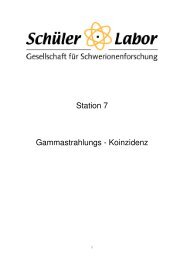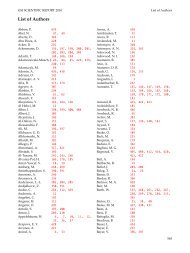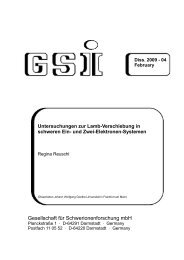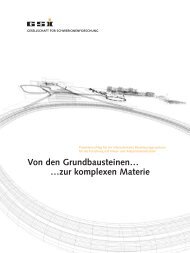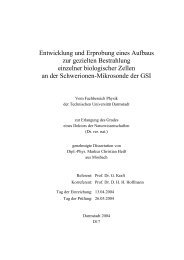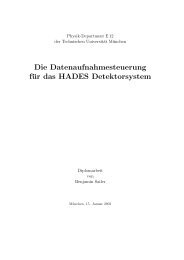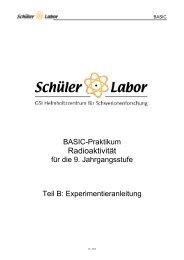CBM Progress Report 2006 - GSI
CBM Progress Report 2006 - GSI
CBM Progress Report 2006 - GSI
Create successful ePaper yourself
Turn your PDF publications into a flip-book with our unique Google optimized e-Paper software.
<strong>CBM</strong> <strong>Progress</strong> <strong>Report</strong> <strong>2006</strong> FEE and DAQ<br />
Requirements and concept<br />
Developments for a future DAQ framework DABC<br />
J. Adamczewski 1 , H.G. Essel 1 , N. Kurz 1 , and S. Linev 1<br />
The Data Acquisition Backbone Core DABC will provide<br />
a general software framework for DAQ tasks over<br />
the next years. It serves as test bed for FAIR detector<br />
tests, readout components tests, data flow investigations<br />
(switched event building) and DAQ controls. Specifically,<br />
the system must be able to handle the large data bandwidth<br />
of experiments with self-triggered front-end electronics<br />
like <strong>CBM</strong> [1]. Additionally, it is necessary to integrate<br />
the current <strong>GSI</strong> standard data acquisition system<br />
MBS [2]. The huge installed MBS equipment cannot be replaced.<br />
Instead, MBS driven front-end components (readout)<br />
should be attachable as data sources to the new framework.<br />
The DABC replaces the MBS event building functionality.<br />
The XDAQ C++ software framework [3] developed for<br />
the CMS experiment at CERN was chosen as base for the<br />
first implementation of DABC. It features:<br />
Task management: One node may contain several XDAQ<br />
Executives (processes); each Executive may contain XDAQ<br />
Applications as threads. Each application may create additional<br />
threads (workloops).<br />
Data transfer management: Peer Transport and Messenger<br />
interfaces.<br />
Hardware integration: Hardware Access Library.<br />
Control support: state machines; process variable Infospaces;<br />
message and error loggers; web server for each Executive.<br />
Evaluation and testing<br />
The developments so far concentrated on performance<br />
and functionality evaluations.<br />
Data transport<br />
Data transport on a fast switched network has been investigated<br />
on a small InfiniBand (IB) linux cluster installed<br />
at <strong>GSI</strong> in 2005. An XDAQ Peer Transport over IB was<br />
implemented based on the uDAPL library to check the<br />
performance of IB data transfer with the XDAQ I2O<br />
messaging mechanism. For package sizes P ≥ 15 kByte<br />
the bandwidth B saturated at 905 MByte/s to be compared<br />
with 955 MByte/s for measurements with direct<br />
uDAPL. However, the rise of the B(P) curve for small<br />
packages was less steep for the XDAQ transport, since<br />
this is ruled by the minimum transfer time τmin (“latency”<br />
overhead of the framework), from ( dB<br />
1 <strong>GSI</strong>, Darmstadt, Germany<br />
dP )P→0 = 1<br />
τmin .<br />
Depending on the benchmark set up, XDAQ showed values<br />
τmin 10...30 µs, well exceeding the plain uDAPL<br />
latency of τmin 4 µs.<br />
Hardware access<br />
As general software interface to attach DAQ hardware like<br />
55<br />
readout boards, XDAQ provides a Hardware Access Library<br />
package [3]. This defines base classes for user-space<br />
communication with boards on a bus (e.g. PCI or VME).<br />
We implemented HAL BusAdapter and DeviceIdentifier<br />
classes for a generic PCI/PCIe driver of the Mannheim<br />
FPGA group 1 .<br />
The new HAL classes were tested with the available<br />
<strong>GSI</strong> PCIGTB2 board. It was possible to access the<br />
board from an XDAQ Application, setting up registers<br />
and reading/writing on the PCIGTB2 internal memory.<br />
Although the tests showed that the general HAL interface<br />
is not sufficient for all cases, (e.g. DMA; exact i/o timing),<br />
it turned out that it is well possible to implement missing<br />
features as methods of the specific HardwareDevice class.<br />
Control System<br />
XDAQ offers a http server on each node to exchange<br />
control messages and monitoring data via SOAP protocol.<br />
We developed a simple prototype of a control GUI as<br />
JAVA application. However, every update of a monitored<br />
value requires an active http/SOAP request from the GUI.<br />
An improved approach for monitoring consists in a<br />
“publisher-subscriber”-model, where each GUI registers to<br />
be updated automatically if a variable changes in the monitored<br />
application. DIM [4] is a well established protocol<br />
library for such a usage. We developed adapter classes to<br />
run a DIM server in the XDAQ executive. XDAQ infospace<br />
variables are exported as DIM services. Additionally, the<br />
XDAQ application state machine can be switched by DIM<br />
commands. The DIM server provides control access from<br />
any other DIM interfaced packages, like the Labview-DIM<br />
interface of the <strong>GSI</strong> CS-framework [5] for a test control<br />
GUI, or the EPICS DIM gateway currently under development<br />
at <strong>GSI</strong> (http://wiki.gsi.de/Epics).<br />
References<br />
[1] “<strong>CBM</strong> technical status report”, <strong>GSI</strong>, January 2005, pp.235<br />
[2] H.G. Essel and N. Kurz, “Multi Branch System homepage”,<br />
http://daq.gsi.de<br />
[3] J. Gutleber and L. Orsini, “XDAQ framework”,<br />
http://xdaqwiki.cern.ch/index.php/Main Page<br />
[4] C. Gaspar, “Distribution Information Management system<br />
DIM”, http://dim.web.cern.ch/dim/<br />
[5] D. Beck and H.Brand, “The CS framework”,<br />
https://sourceforge.net/projects/cs-framework/<br />
1 thanks to G. Marcus, H. Singpiel, and A. Kugel, Technische Informatik<br />
V, Universtät Mannheim



